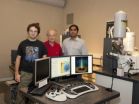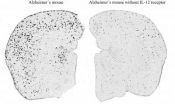(Press-News.org) BUFFALO, N.Y. -- A new University at Buffalo study in the journal Geophysical Research Letters examines maar craters, which resemble the bowl-like cavities formed by meteorites but are in some ways more mysterious.
Scientists often can discern pertinent details about meteorites -- when they struck, how large they were, the angle they approached Earth and other information -- by measuring the diameter and volume of the impact crater.
Maar craters, which form when fissures of magma beneath Earth's surface meet groundwater, causing volcanic explosions, are not as telling, scientists say. The possibility of multiple explosions at varying depths led most scientists to believe that measuring a maar's size is not the best way to gauge the energy of individual explosions or determine future hazards.
UB geologist Greg A. Valentine, PhD, and other volcano researchers found instead that examining a maar's shape and the distance it ejects magma, ash and other debris to be a more accurate barometer of the eruption's force. The findings are important, he said, because they could assist scientists in estimating how big future volcano eruptions might be.
"It's something that, up until this point, had only been suspected," said Valentine, a professor of geology and lead author of the Geophysical Research Letters paper. "The simulations we did prove that crater diameter is not a good indicator of explosion energy for these volcanoes."
The scientists drew their conclusions on a series of UB-funded experiments conducted last summer at a test site in Ashford, N.Y. They built three test beds of gravel, limestone and asphalt. In the first experiment (see the video below) one charge of TNT and plastic explosive was detonated.
In subsequent experiments, the charge was divided into three parts and detonated individually at different depths. The final dimensions of each crater were about the same. That matters, according to Valentine, because it shows that it's easy to overestimate the energy of explosions if one assumes that the crater comes from one blast, not several.
The dispersal of ejected material differed depending on the location of the charge. For example, the first experiment launched debris more than 50 feet from the crater. Debris from subsequent experiments simulating blasts further underground mostly went up in the air and fell back into the crater or around its rim. As a result, it forced dusty gas -- like the ash that shut down air travel in Iceland and beyond in 2010 -- into the surrounding air. This can be seen in the video below.
Although the experiments provided valuable information, Valentine said they were similar to a practice run. More detailed experiments are being planned for the near future, he said.
###
Related information:
Simulating Volcano Eruptions, One Blast at a Time
http://www.buffalo.edu/news/13570
Greg A. Valentine, PhD,
Professor of Geology
Director, Center for Geohazards, University at Buffalo
http://www.acsu.buffalo.edu/~gav4/home_page.htm END
How does a volcanic crater grow? Grab some TNT and find out
Researchers blow holes into the Earth to study maar craters and, hopefully, better predict the next big volcano
2012-11-26
ELSE PRESS RELEASES FROM THIS DATE:
BioMAP screening procedure could streamline search for new antibiotics
2012-11-26
Researchers at the University of California, Santa Cruz, have developed a new strategy for finding novel antibiotic compounds, using a diagnostic panel of bacterial strains for screening chemical extracts from natural sources.
Public health officials warn of a looming antibiotic crisis due to the steady increase in antibiotic resistance and a dramatic decline in the development of new antibiotics. Most currently available antibiotics are derived from natural compounds produced by microorganisms such as bacteria and fungi. New antibiotics developed by drug companies are ...
New device hides, on cue, from infrared cameras
2012-11-26
Cambridge, Mass. - November 26, 2012 - Now you see it, now you don't.
A new device invented at the Harvard School of Engineering and Applied Sciences (SEAS) can absorb 99.75% of infrared light that shines on it. When activated, it appears black to infrared cameras.
Composed of just a 180-nanometer-thick layer of vanadium dioxide (VO2) on top of a sheet of sapphire, the device reacts to temperature changes by reflecting dramatically more or less infrared light.
Announced today in the journal Applied Physics Letters, and featured on its cover, this perfect absorber ...
Seizures linked to surgery drugs can be prevented by anesthetics, U of T team finds
2012-11-26
Two drugs commonly given during cardiac surgery can lead to convulsive seizures, but anesthetics can help cut the risk, according to new research from the Faculty of Medicine at the University of Toronto.
Patients undergoing complex heart operations or trauma surgery are often given tranexamic acid (TXA) and aminocaproic acid (EACA) to reduce blood loss. But Faculty of Medicine researchers found these drugs are associated with a four-to-six-fold increase in post-operative seizures. The risk is highest for cardiac surgery patients – between three and seven and a half per ...
Researchers test novel power system for space travel
2012-11-26
LOS ALAMOS, N.M., Nov. 26, 2012 — A team of researchers, including engineers from Los Alamos National Laboratory, has demonstrated a new concept for a reliable nuclear reactor that could be used on space flights.
The research team recently demonstrated the first use of a heat pipe to cool a small nuclear reactor and power a Stirling engine at the Nevada National Security Site's Device Assembly Facility near Las Vegas. The Demonstration Using Flattop Fissions (DUFF) experiment produced 24 watts of electricity. A team of engineers from Los Alamos, the NASA Glenn Research ...
Cyber Monday at CocktailNerd Brings the Biggest E-Cig Savings of 2012
2012-11-26
Cyber Monday is here and it brings one last chance for electronic cigarette fans to save big on all of their favorite e-cig starter kits and accessories. CocktailNerd.com is offering readers big savings on Cyber Monday with exclusive deals that will expire at midnight. This is the year's biggest sale on all of the best electronic cigarettes brands and with exclusive coupon codes from Cocktail Nerd, e-cig shoppers can save up to 65% on all of their favorite products.
Cocktail Nerd is the Internet's most cutting edge website for e-cig news, reviews, and savings. The site ...
Alzheimer's disease in mice alleviated promising therapeutic approach for humans
2012-11-26
Alzheimer's disease is one of the most common causes of dementia. In Germany and Switzerland alone, around 1.5 million people are affected, and forecasts predict a doubling of the number of patients worldwide within the next 20 years. The accumulation of particular abnormal proteins, including amyloid-ß (Aβ) among others, in patients' brains plays a central role in this disease. Prof. Frank Heppner from the Department of Neuropathology at Charité and his colleague Prof. Burkhard Becher from the Institute for Experimental Immunology at the University of Zurich were ...
Patient's own immune cells may blunt viral therapy for brain cancer
2012-11-26
COLUMBUS, Ohio – Doctors now use cancer-killing viruses to treat some patients with lethal, fast-growing brain tumors. Clinical trials show that these therapeutic viruses are safe but less effective than expected.
A new study led by researchers at the Ohio State University Comprehensive Cancer Center – Arthur G. James Cancer Hospital and Richard J. Solove Research Institute (OSUCCC – James) shows that the reason for this is in part due to the patient's own immune system, which quickly works to eliminate the anticancer virus.
The findings, published in the journal Nature ...
Temple-Penn researchers identify calcium 'accelerator' to keep cell power supply going
2012-11-26
(Philadelphia, PA) – A team of scientists from Temple University School of Medicine and the University of Pennsylvania has moved another step closer to solving a decades-long mystery of how the all-important flow of calcium into the cell's power source, the mitochondria, is controlled.
By painstakingly shutting down the activity of 50 genes, one at a time, they have identified a protein, MCUR1, which hugs the inside of the mitochondrial membrane and is part of an elaborate mitochondrial channel pore system. MCUR1 acts as an accelerator to help regulate calcium coming ...
Exercise rate related to improvements in Parkinson’s disease
2012-11-26
CHICAGO – People with Parkinson's disease benefit from exercise programs on stationary bicycles, with the greatest effect for those who pedal faster, according to a study presented today at the annual meeting of the Radiological Society of North America (RSNA). Functional connectivity magnetic resonance imaging (fcMRI) data showed that faster pedaling led to greater connectivity in brain areas associated with motor ability.
Parkinson's disease is a chronic, progressive disorder of the central nervous system. Early-stage symptoms like shaking and difficulty with walking ...
Too much or too little activity bad for knees
2012-11-26
CHICAGO – Both very high and very low levels of physical activity can accelerate the degeneration of knee cartilage in middle-aged adults, according to a new study presented at the annual meeting of the Radiological Society of North America (RSNA).
Nearly one in every two people in the U.S. may develop knee osteoarthritis by age 85, according to the Centers for Disease Control and Prevention. By 2030, an estimated 67 million Americans over the age of 18 are projected to have physician-diagnosed arthritis.
Researchers at the University of California in San Francisco ...
LAST 30 PRESS RELEASES:
Numbers in our sights affect how we perceive space
SIMJ announces global collaborative book project in commemoration of its 75th anniversary
Air pollution exposure and birth weight
Obstructive sleep apnea risk and mental health conditions among older adults
How talking slows eye movements behind the wheel
The Ceramic Society of Japan’s Oxoate Ceramics Research Association launches new international book project
Heart-brain connection: international study reveals the role of the vagus nerve in keeping the heart young
Researchers identify Rb1 as a predictive biomarker for a new therapeutic strategy in some breast cancers
Survey reveals ethical gaps slowing AI adoption in pediatric surgery
Stimulant ADHD medications work differently than thought
AI overestimates how smart people are, according to HSE economists
HSE researchers create genome-wide map of quadruplexes
Scientists boost cell "powerhouses" to burn more calories
Automatic label checking: The missing step in making reliable medical AI
Low daily alcohol intake linked to 50% heightened mouth cancer risk in India
American Meteorological Society announces Rick Spinrad as 2026 President-Elect
Biomass-based carbon capture spotlighted in newly released global climate webinar recording
Illuminating invisible nano pollutants: advanced bioimaging tracks the full journey of emerging nanoscale contaminants in living systems
How does age affect recovery from spinal cord injury?
Novel AI tool offers prognosis for patients with head and neck cancer
Fathers’ microplastic exposure tied to their children’s metabolic problems
Research validates laboratory model for studying high-grade serous ovarian cancer
SIR 2026 delivers transformative breakthroughs in minimally invasive medicine to improve patient care
Stem Cell Reports most downloaded papers of 2025 highlight the breadth and impact of stem cell research
Oxford-led study estimates NHS spends around 3% of its primary and secondary care budget on the health impacts of heat and cold in England
A researcher’s long quest leads to a smart composite breakthrough
Urban wild bees act as “microbial sensors” of city health.
New study finds where you live affects recovery after a hip fracture
Forecasting the impact of fully automated vehicle adoption on US road traffic injuries
Alcohol-related hospitalizations from 2016 to 2022
[Press-News.org] How does a volcanic crater grow? Grab some TNT and find outResearchers blow holes into the Earth to study maar craters and, hopefully, better predict the next big volcano

